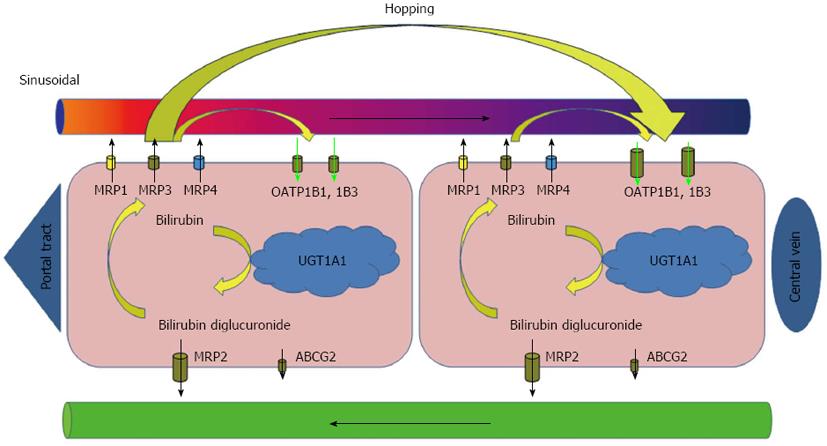Copyright
©2013 Baishideng Publishing Group Co.
World J Gastroenterol. Oct 14, 2013; 19(38): 6398-6407
Published online Oct 14, 2013. doi: 10.3748/wjg.v19.i38.6398
Published online Oct 14, 2013. doi: 10.3748/wjg.v19.i38.6398
Figure 1 Liver cycle of conjugated bilirubin.
Bilirubin conjugated in endoplasmic reticulum of hepatocytes is secreted into the bile. This process is mediated by MRP2/ABCC2 with possible minor contribution of other transporters (ABCG2) at the canalicular membrane of hepatocytes. In addition, even under physiologic conditions, a fraction of bilirubin conjugates is secreted by MRP3 across the sinusoidal membrane into the blood, from where they can be subsequently reuptaken by sinusoidal membrane-bound OATP1B1 and OATP1B3 transporters. The highest overall expression of OATP1Bs has been demonstrated at the centrilobular hepatocytes. The process of substrate shifting (hopping) from periportal to centrizonal hepatocytes may act as a protection of the periportal hepatocytes against elevated concentrations of various xenobiotics. MRP: Multidrug resistance-associated protein; OATP: Organic anion transporting polypeptide; UGT: Uridine diphosphate glucuronosyltransferase; ABC: ATP-binding cassette.
- Citation: Sticova E, Jirsa M. New insights in bilirubin metabolism and their clinical implications. World J Gastroenterol 2013; 19(38): 6398-6407
- URL: https://www.wjgnet.com/1007-9327/full/v19/i38/6398.htm
- DOI: https://dx.doi.org/10.3748/wjg.v19.i38.6398









